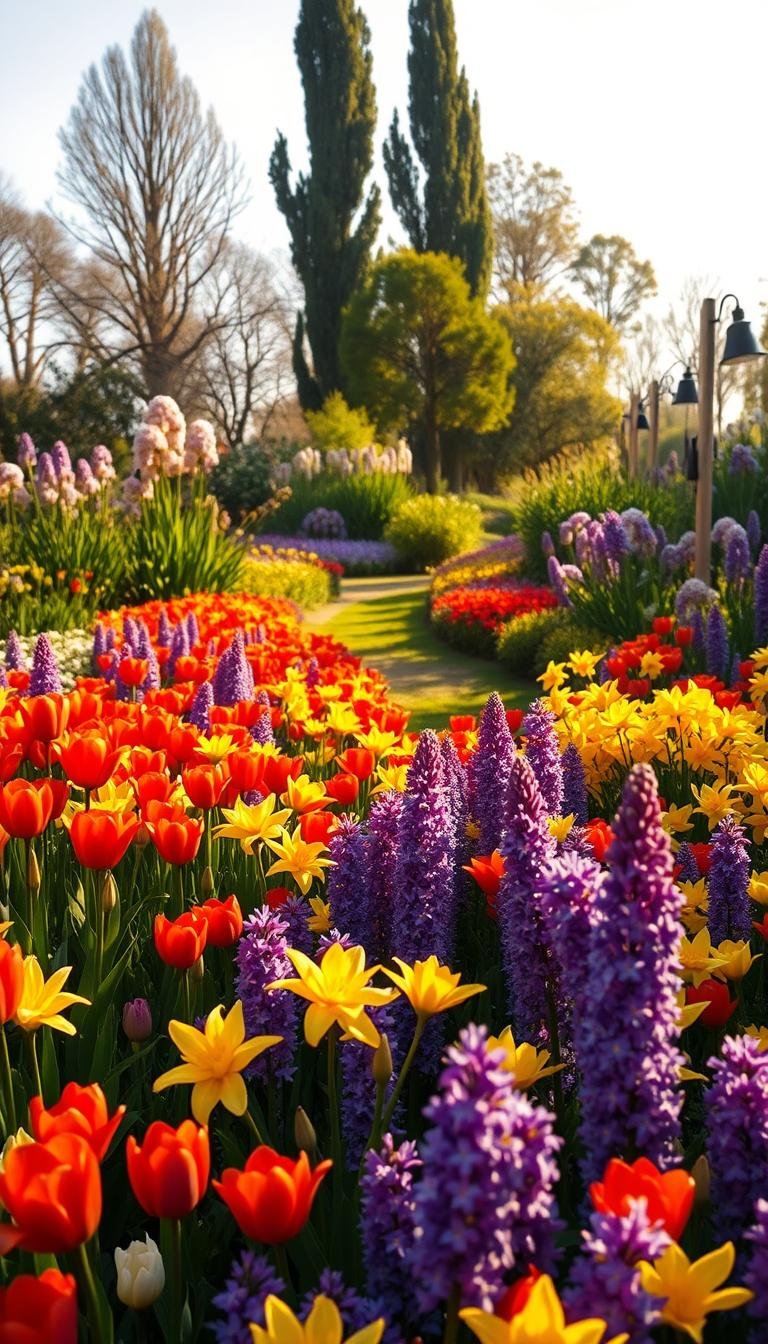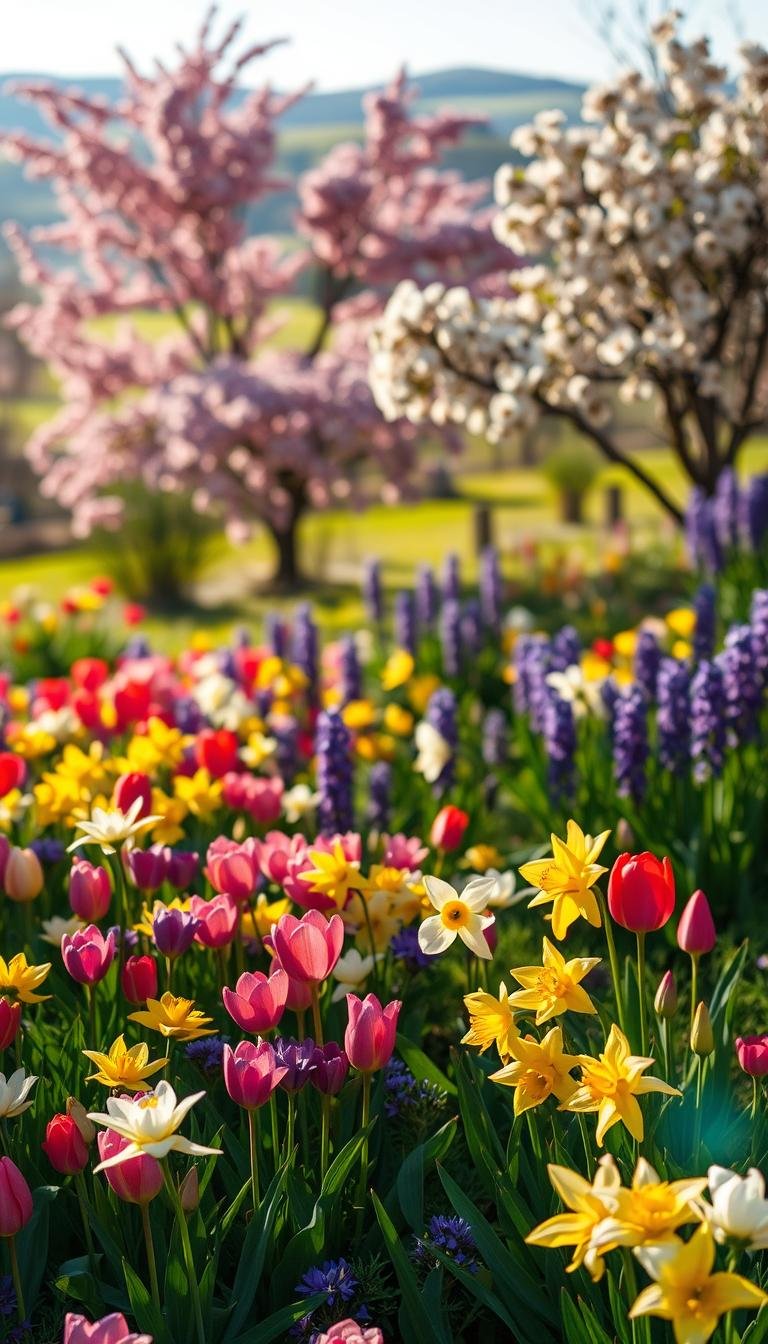This post may contain affiliate links. If you click and buy, we may earn a small commission at no extra cost to you. Learn more.
Japanese Flowers are known for their delicate beauty and deep cultural roots. They can be found in ancient gardens and modern landscapes. These blooms carry stories of Japan’s history and art.
Their floral symbolism in Japan shows values like resilience and renewal. This makes them more than plants—they are living symbols.
Japanese Flowers are changing global gardening trends. They mix tradition with modern design. This article will show their unique traits, seasonal cycles, and how to grow them.
Learn why gardeners around the world love their elegance and meaning.
Contents
- 1 The Beauty of Japanese Flowers
- 2 Iconic Japanese Flowers
- 3 Creating a Japanese Flower Garden
- 4 Seasonal Blooms: A Year-Round Delight
- 5 Edible Japanese Flowers
- 6 Unique Flower Arranging Styles
- 7 Japanese Flowers in Art and Literature
- 8 Caring for Japanese Flowers
- 9 Conclusion: Embracing the Charm of Japanese Flowers
The Beauty of Japanese Flowers
Japanese Flowers are more than plants—they tell stories in our daily lives. They are found in temples and tea ceremonies, carrying deep meanings from history. They shape traditions and inspire art.
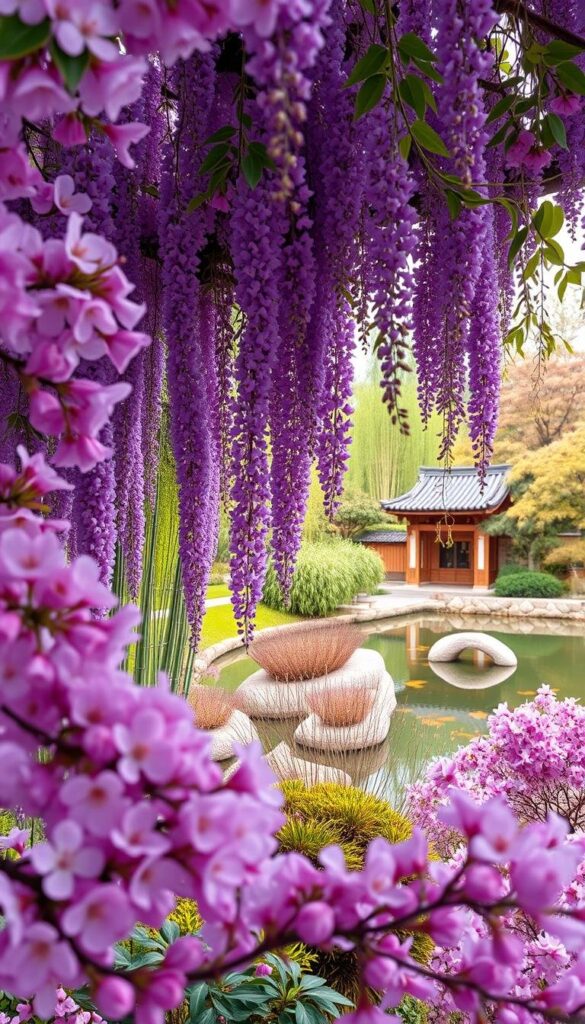
Cultural Significance of Flowers
Flowers in Japan symbolize life’s fleeting beauty. The sakura (cherry blossom) represents mono no aware, the bittersweet awareness of impermanence. Chrysanthemums, with their detailed patterns, symbolize longevity and power, even on Japan’s imperial crest. These symbols turn gardens into living poetry.
Seasonal Changes in Blooming
Japan loves blooms that follow the seasons. Winters bloom with ume (plum) flowers, while spring’s cherry blossoms signal renewal. Summer brings botan (peonies), and autumn features kiku (chrysanthemums). This rhythm celebrates nature’s timing.
Popular Japanese Festivals Featuring Flowers
Hanami parties under cherry blossoms started in the Nara period. They mix picnics with deep thought. The Kanto ’s Hitachi Seaside Park hosts plum festivals, where Ume Matsuri draws crowds to admire pink blooms. Modern chrysanthemum exhibitions showcase floral art in Japanese culture, with delicate arrangements competing in Kyoto’s annual displays. These events remind us: flowers aren’t just seen—they’re experienced.
Iconic Japanese Flowers
Japan is famous for its Japanese Flowers like Cherry Blossoms and plum blossoms. These seasonal flowers in Japan are more than just plants. They mark time, inspire art, and connect past and present. Let’s explore their stories.
Sakura (Cherry Blossoms)
Cherry Blossoms are short-lived but incredibly beautiful. They cover parks in soft pinks. Varieties like Somei Yoshino and Yoshino are the most common.
Their brief time in bloom is a reminder of life’s fleeting nature. This theme is celebrated across Japan during hanami (flower viewing) parties.
- Peak bloom: Late March to early April
- Colors: White, pale pink, deep magenta
- Fun fact: Blooms tracked via Japan’s cherry blossom front forecasts
Ume (Plum Blossoms)
Ume blooms arrive early, painting winter’s end with pink and white. These flowers are hardy and bloom as early as January. Artists have celebrated them in ukiyo-e woodblock prints for centuries.
Chrysanthemums
The Japanese imperial crest features this autumn star. Chrysanthemums bloom in layered petals from September to November. They symbolize longevity and power.
They are celebrated in kiku festivals and royal ceremonies.
Creating a Japanese Flower Garden
Turn your outdoor area into a peaceful retreat with Japanese gardens inspiration. These tips guide you in growing real flowers and designing spaces that blend nature and simplicity. You can adapt these traditional ideas to fit any U.S. climate or space.
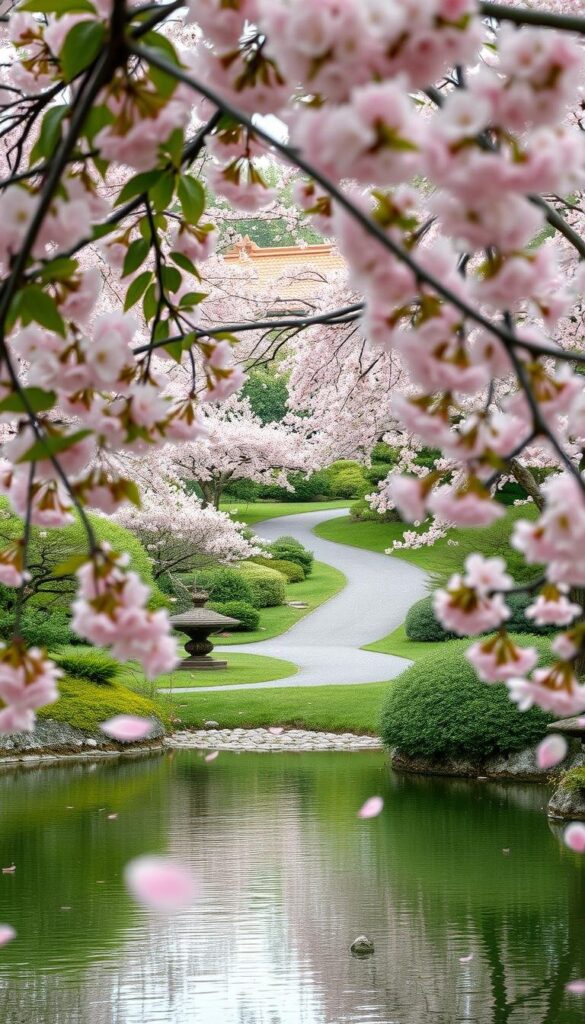
Essential Plants for Your Garden
For zones 5–9, pick Cherry Blossoms (Prunus yedoensis or ‘Kwanzan’). Mix them with evergreens, moss, and native ferns. Ume (plum blossoms) and late-blooming chrysanthemums bring color through the seasons. Dwarf varieties are great for containers.
Designing the Perfect Layout
- Use asymmetry—avoid straight lines. Place stones or lanterns in uneven clusters.
- Frame views beyond your garden (shakkei) to blend natural surroundings.
- Enclose spaces with bamboo fencing or low hedges to create intimate areas.
Maintenance Tips for Success
- Prune Cherry Blossoms in late winter to promote spring blooms.
- Mulch beds with bark chips to retain moisture and suppress weeds.
- Check for pests like aphids monthly; use neem oil for organic control.
Begin small—add one Japanese Flower at a time. Local nurseries like Kitayama Gardens or Evergreen Nursery offer advice for your area. Embrace imperfection; a weathered stone or faded bloom adds character.
Seasonal Blooms: A Year-Round Delight
Japanese gardens show their beauty through the seasons, changing with each one. They fill the air with seasonal flowers in Japan. Each flower comes out when nature says it’s time, making every visit special. Let’s see how these flowers make gardens alive all year.
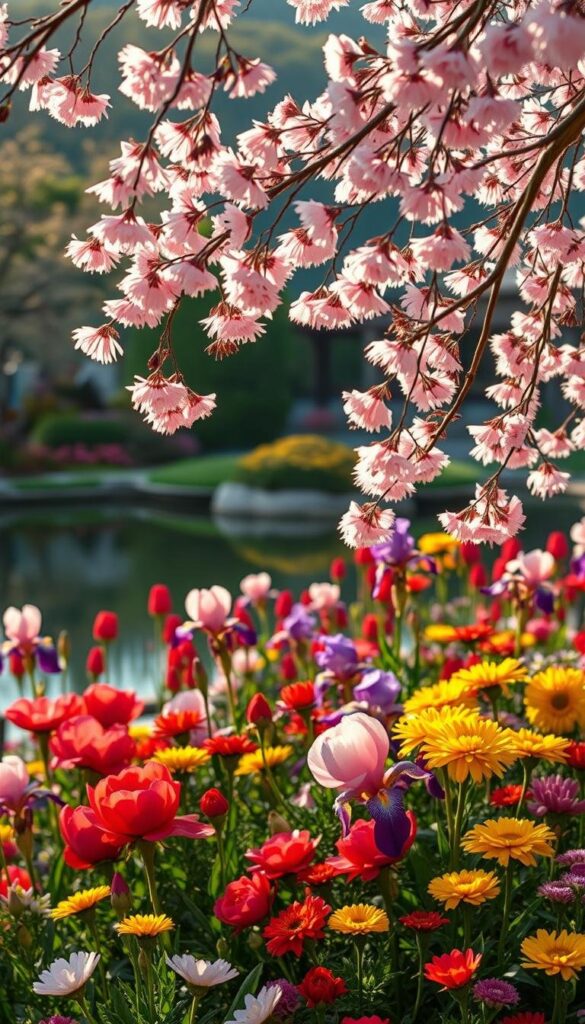
Spring Flowers
Sakura gets all the attention in spring, but other Japanese flowers add to the beauty. Azaleas show off in pink and white, and tree peonies have huge flowers. Wisteria vines fall in purple and lavender, covering garden pavilions.
These flowers love the shade and shelter.
Summer Blossoms
Summer brings hydrangeas to Japanese gardens, with their blue and pink flowers. Japanese irises stand tall by ponds, and lotus flowers float on the water, symbolizing purity. Festivals like the Hydrangea Festival in Nikko celebrate these flowers.
“In every season, a flower teaches us to embrace life’s fleeting moments.”
Fall and Winter Varieties
Even in cold months, camellias bloom in red and white, standing out against autumn leaves. Winter jasmine lights up the gray with golden buds, and witch hazel’s flowers fill the air with scent. These plants show Japanese gardens can even bloom in frost.
Plan your garden with these flowers in mind. Mix spring peonies with summer lotus, and let winter camellias follow. Every season brings a new chance to enjoy nature’s art.
Edible Japanese Flowers
Japanese Flowers aren’t just for gardens—they’re also a key part of food traditions. They add special flavors and cultural depth to dishes. Learn how these blooms bring beauty to both gardens and the dining table.
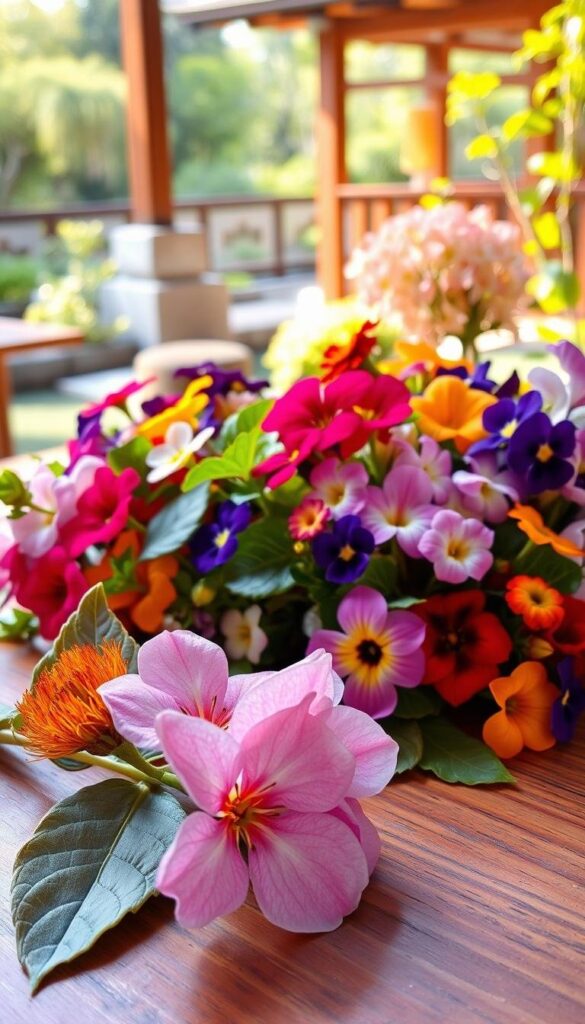
Intriguing Taste Experiences
Edible flowers like sakura (cherry blossoms) taste sweet. Shiso flowers have a peppery flavor. Chrysanthemums add earthy notes to teas, and ume (plum) petals are tangy.
These blooms are picked at the right time for the best taste and nutrition.
“The petals of the chrysanthemum are nature’s own tea leaves,” says a Kyoto-based chef, highlighting their centuries-old use in wellness rituals.
Recipes Featuring Edible Flowers
- Sakura Mochi: Wrap sticky rice in salted cherry leaves, studded with sweet red bean paste.
- Shiso Infused Sake: Steep young shiso leaves in rice wine for a refreshing aperitif.
- Ume Syrup: Simmer pickled plum blossoms with sugar into a tangy glaze for pancakes.
Make sure to get flowers from trusted growers to avoid pesticides. If you can’t find certain flowers, try using rose petals for a similar taste. Start with small amounts—like sprinkling dried wisteria on salads or making a light chrysanthemum tea—to enjoy this edible art safely.
Unique Flower Arranging Styles

Explore the beauty of Ikebana, a centuries-old art of traditional Japanese floral arrangements. It turns simple stems into beautiful, balanced pieces. Beginners can start with basic tools and local flowers to learn this craft.
Ikebana: The Art of Japanese Flower Arrangement
Ikebana is deeply rooted in Zen philosophy. It focuses on harmony between humans and nature. The art follows three main schools:
- Ikenobo: Emphasizes seasonal themes and classic forms.
- Sogetsu: Uses bold colors and modern materials like wire or glass.
- Ohara: Includes natural landscapes in arrangements.
Learning traditional Japanese flower arranging techniques begins with simple designs. The “moribana” style uses shallow containers.
Modern Takes on Traditional Arrangements
Artists today mix Ikebana with modern trends. They use metal vases or abstract sculptures. Floral studios offer workshops combining silk flowers with traditional methods.
Try it at home: place a single branch in a vase. Let its shape guide your arrangement. Small blooms like daisies or eucalyptus work well.
Japanese Flowers in Art and Literature
Flowers in Japan have a big role in art and literature. They are used in both art and words, showing their deep meaning. Japanese Flowers are more than just pretty; they carry cultural messages.
Representation in Traditional Japanese Art
Ukiyo-e woodblock prints and screen paintings show the beauty of flowers. Artists like Ogata Korin used irises in his Rōsankuizu screens. Hokusai mixed cherry blossoms with Mount Fuji in his One Hundred Views.
Ceramics and kimono patterns also feature flowers. Peonies, chrysanthemums, and wisteria are used. Each flower has its own meaning, like purity or imperial power.
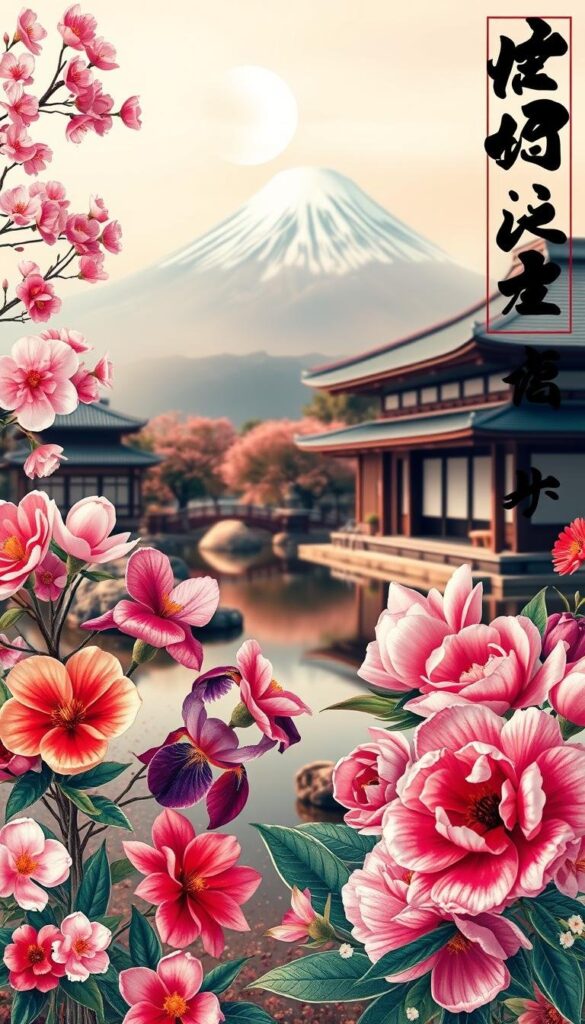
Flowers in Haiku Poetry
Haiku poets like Bashō used kigo, words that show the season. A famous example is:
Momiji bareru / yami mo hayaku keri / aki no kaze
(“Maple leaves fall / even darkness comes quickly / autumn wind”). Maple leaves symbolize short-lived beauty, a key idea in Japanese art.
These poems make flowers a way to connect with nature. They remind us to enjoy life’s brief moments, like the beauty of cherry blossoms.
Caring for Japanese Flowers
Growing Japanese Flowers in American gardens needs careful attention. Start by knowing their soil needs. Many, like hydrangeas and camellias, do best in slightly acidic soil. Test your soil pH yearly and adjust it with compost or sulfur to get it to 5.5–6.5.
Mulch helps keep moisture in and keeps the temperature right. It’s like giving them a taste of their native home.
Soil and Water Requirements
- Soil: Use organic matter to improve drainage in clay-heavy soils.
- Watering: Water deeply but infrequently to encourage deep root growth.
- Climate zones: In colder regions, plant cold-tolerant varieties like winter jasmine. In warmer zones, ensure afternoon shade for heat-sensitive species.
Pest and Disease Management
Keep plants safe with eco-friendly methods inspired by traditional Japanese flower arranging. For aphids, spray a mix of water and dish soap. If you have fungal issues, improve air circulation by pruning overcrowded branches.
Always rotate plant locations annually to disrupt pest cycles.
Adjust to your USDA zone: Northern gardeners should mulch camellias heavily before frost. Southern growers can use floating row covers to simulate chill hours for plants like sakura. Small adjustments ensure beauty aligns with nature’s balance.
Conclusion: Embracing the Charm of Japanese Flowers
Japanese gardens are a mix of tradition and nature. They offer peaceful places where beauty and culture meet. Let’s look at the key points and inspire you to start your journey in this colorful world.
Final Thoughts on Cultivation
Starting with good soil and regular care is key. Prune often and pick plants like plum or chrysanthemum that are tough. Facing pests or changes in seasons is a chance to learn. Each flower shows your hard work, making your garden a masterpiece.
Encouragement to Explore Local Varieties
Find nurseries that focus on Asian plants or visit gardens with Japanese sections. Take ikebana classes to learn about traditional flower arranging. Check out local festivals that celebrate flowers. Begin with a small plant, like a cherry blossom, or a simple arrangement. These plants turn outdoor areas into calm places, filled with history and beauty.
To bring you cozy inspiration more efficiently, we sometimes use AI to assist in content creation — but every word and idea is carefully shaped by our team. See our AI Disclosure for more info.




